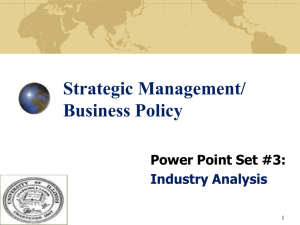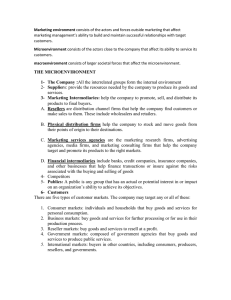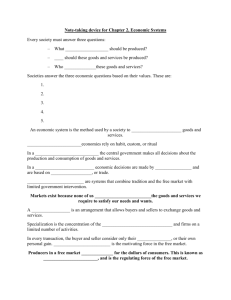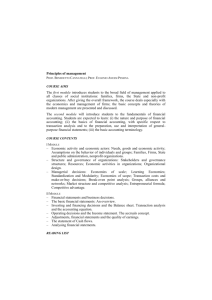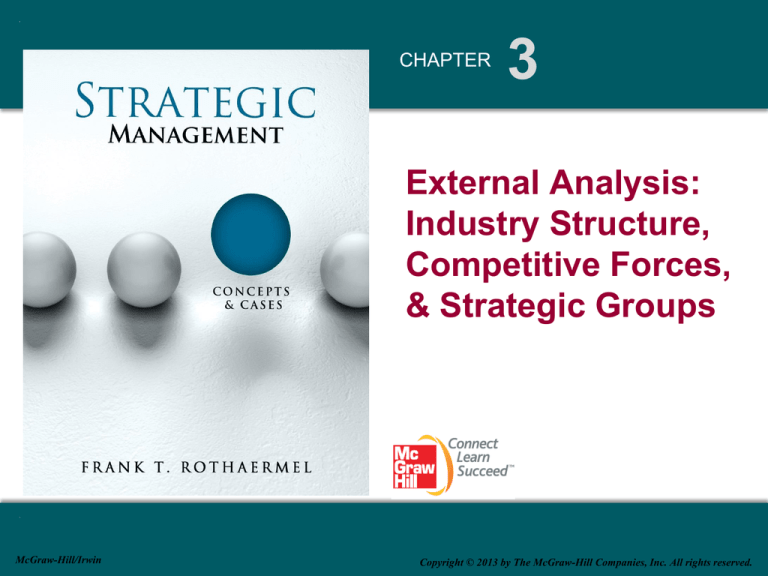
CHAPTER
3
External Analysis:
Industry Structure,
Competitive Forces,
& Strategic Groups
McGraw-Hill/Irwin
Copyright © 2013 by The McGraw-Hill Companies, Inc. All rights reserved.
Part 1 Strategy Analysis
3–2
LO 3-1 Apply the PESTEL model to organize and assess the impact
of external forces on the firm.
LO 3-2 Apply the structure-conduct-performance (SCP) model to explain
the effect of industry structure on firm profitability.
LO 3-3 Apply the five forces model to understand the profit potential of the
firm’s industry.
LO 3-4 Describe the strategic role of complements in creating positivesum co-opetition.
LO 3-5 Understand the role of industry dynamics and industry
convergence in shaping the firm’s external environment.
LO 3-6 Apply the strategic group model to reveal performance differences
between clusters of firms in the same industry.
3–3
Chapter Case 3
Build Your Dreams (BYD) to
Sidestep Entry Barriers
• Changing U.S. car market
More competition from outside the U.S.
However, NO new entry firms in the last 2 decades
High barriers to entry
• BYD led by founder, Wang Chuanfu in China is
entering the car market
• Batteries to cars…bypassing many hurdles
Electric cars have fewer parts
BYD has the battery technology
Selling in China, Africa, & South America
Hybrid Car Video
3–4
BYD Electric Vehicles
• What are their chances of success?
• Warren Buffet invested for 10% equity.
-- Sticker price half that of a Chevy Volt.
-- Many obstacles are ahead
• Which PESTEL factors will be most important for
electric vehicles in the 21st century?
• BYD was China’s fastest-growing carmaker
Sold more than 500,000 cars in 2010
Shanghai government subsidy for EVs
3–5
PESTEL Framework
• Political
• Technological
Government pressures
Innovation
Subsidies and incentives
Diffusion
Differences in countries,
Research & development
states, and regions
• Economic
• Environmental
Growth rates
Global warming
Interest rates
Sustainability
Employment levels
Pollution
Currency exchange
• Sociocultural
• Legal
Norms, culture, values
Court system
Demographics
Legislation
Lifestyle changes
Hiring laws
3–6
EXHIBIT 3.1
The Firm Embedded in Its External Environment
3–7
STRATEGY HIGHLIGHT 3.1
UBS Relents to Pressure
by U.S. Government
• Large Swiss bank in trouble…
U.S. government accused UBS of aiding in tax evasion
Billions of dollars moved offshore
Names of 52,000 U.S. citizens sought
Eventually over 4,450 names were released
Imperils Swiss Bank secrecy
Historically, a competitive advantage
1–8
LO 3-1 Apply the PESTEL model to organize and assess the impact of
external forces on the firm.
LO 3-2 Apply the structure-conduct-performance (SCP) model to
explain the effect of industry structure on firm profitability.
LO 3-3 Apply the five forces model to understand the profit potential of the
firm’s industry.
LO 3-4 Describe the strategic role of complements in creating positivesum co-opetition.
LO 3-5 Understand the role of industry dynamics and industry
convergence in shaping the firm’s external environment.
LO 3-6 Apply the strategic group model to reveal performance differences
between clusters of firms in the same industry.
3–9
EXHIBIT 3.2
Industry Structures along the Continuum
Efficient Markets
• The efficient market hypothesis, in financial markets, is one
in which prices reflect information instantaneously and one in
which extra-ordinary profit opportunities are thus rapidly
dissipated by the action of profit-seeking individuals in the
market.
• How well does the efficient market hypothesis for capital
markets apply to product markets?
If the efficient market hypothesis applied fully to product markets
then we should see over time equalization in risk-adjusted rates
of return across industries.
What do the data support?
3–11
Differences in Profitability Across Industries
Average Return on Equity in US Industries, 1982-1993
16.5%
90
13.8%
11.7%
100
80
First Quartile
Average
22.2%
Fourth Quartile
Average
9.3%
70
60
Number
50
of
Industries
40
Average = 14.7%
Median = 13.8%
30
20
10
0
32%
30%
28%
26%
24%
22%
20%
18%
16%
14%
12%
10%
8%
6%
4%
2%
Return on Equity (Percent)
Note:
Source:
Return on Equity = Net Income / Year End Shareholders’ Equity; Analysis based on sample of 593 industries
Silverman 2000
© 2005 Mara Lederman, Rotman School of Management
12
Some Industries Are More Profitable Than
Differences in Profitability Across Selected Industries
Others
Pharmaceuticals
Semiconductors
ROE & ROA - Selected Industries, 1989
Dental equipment
30%
Drug stores
25%
Race track operations
20%
Engineering services
ROE
ROA
15%
Cable television service
10%
Scheduled air transport
5%
-5
0
5
10
15
20
25
Operating income / assets, 1988-95 (%)
0%
Tires / Rubber
Source: Pankaj Ghemawat and Jan W.Pharmaceuticals
Rivkin, “Creating Competitive Advantage”
© 2005 Mara Lederman, Rotman School of Management
Home Appliances
13
Within Industries, Some Competitors Perform Better
than Others.
Differences in Profitability Within Selected Industries
Semiconductor Industry
IntelROE - Pharmaceutical Industry 1989
60%Texas
50%
Instruments
Motorola
AMD
40%
Analog Devices
30%
National Semiconductor
20%
-5
0
5
10
15
20
25
Operating income / assets, 1988-95 (%)
10%
0%
Amgen
AMP
Eli Lilly
Merck
Source: Pankaj Ghemawat and Jan W. Rivkin, “Creating Competitive Advantage”
© 2005 Mara Lederman, Rotman School of Management
Mylan
Pfizer
14
15
Decomposition of Variance in Profitability
Year
2%
Industry
18%
Corporate
parent
4%
Transient
46%
Business
segment
30%
Source: Anita M. McGahan and Michael E. Porter, “How Much Does Industry Matter Really?” Strategic Management Journal, 1997
© 2005 Mara Lederman, Rotman School of Management
16
Three Factors Determining Company Performance
• Industry Context
e.g., during the last two decades, companies in the airlines
industry have been persistently less profitable than those in
the pharmaceutical industry
• National Context
e.g., world’s most successful consumer electronics firms are
in Japan
• Company Capabilities and Strategies
e.g., Wal-mart and Southwest Airlines
17
Structure-Conduct-Performance
Industry Structure
• Number of buyers
and sellers
• Degree of product
differentiation
• Barriers to entry
• Cost structures
• Vertical integration
• Alliances
Firm Conduct
• Pricing
• Advertising
• R&D
• Investment in
plant and
equipment
Performance
• Econ profits
• Accounting
profits (ratios)
• NPV/DCF
• MVA/EVA
• Tobin’s Q
18
19
LO 3-1 Apply the PESTEL model to organize and assess the impact of
external forces on the firm.
LO 3-2 Apply the structure-conduct-performance (SCP) model to explain
the effect of industry structure on firm profitability.
LO 3-3 Apply the five forces model to understand the profit potential
of the firm’s industry.
LO 3-4 Describe the strategic role of complements in creating positivesum co-opetition.
LO 3-5 Understand the role of industry dynamics and industry
convergence in shaping the firm’s external environment.
LO 3-6 Apply the strategic group model to reveal performance differences
between clusters of firms in the same industry.
3–20
Competitive Forces and Firm Strategy
• The Five Forces Model
The classic industry analysis model
• Threat of Entry/Barriers to Entry
Note: High barriers to entry means threat of entry is low
• Power of Suppliers
• Power of Buyers
• Threat of Substitutes
• Rivalry Among Existing Competitors
3–21
EXHIBIT 3.3
Porter’s Five Forces Model
5 forces video- M. Porter
Source: Porter, M. E. (2008), “The five competitive forces that shape strategy,” Harvard Business Review
3–22
Barriers To Entry
• The free entry and free exit assumption that works
reasonably well for describing financial markets seems
to be a premise that strays so far from our world of
experience that the assumption impedes our
understanding of real-world product competition.
• Thus, empirical evidence suggests
that (risk-adjusted) ROE does
NOT equalize in the long run.
3–23
A Taxonomy of Barriers to Entry
• (1) Economies of Scale
Product-specific economies of scale
Lower setup costs as a percentage of total costs
More specialized machinery and tooling (e.g., Honda)
Plant-specific economies of scale
Engineers’ 2/3 rule: Since the area of a sphere or cylinder varies as
two-thirds power of volume, the cost of constructing process industry
plants can be expected to rise as two thirds power of their output
capacity. (This rule applies to petroleum refining, cement making,
iron ore reduction and steel conversion).
Also “economies of massed reserves”
3–24
A Taxonomy of Barriers to Entry
• Economies of Scale
Multi-product economies of scale
(“economies of scope”)
Example: Cost (Iron, Steel) < Cost (Iron) + Cost (Steel)
Key idea: Shareable input (In this case, thermal
economies in the production of iron and steel)
Modern examples: Aircraft, Automobiles,
Consumer electronics, Household Appliances;
Personal Computers, Software, Power Tools
Multi-plant economies of scale
Economies of multi-plant production, investment, and
physical distribution.
3–25
Examples of Economies of Scope
• Aircraft: Common wing, nose, and tail components allow
several models to be leveraged using different numbers of
fuselage modules to create aircraft of different lengths and
passenger capacities by Boeing and Airbus Industries.
• Automobiles: The Taurus platform was leveraged to provide
the basis for Taurus sedans and minivans.
• Consumer Electronics: Over 160 variations of the Sony
Walkman were leveraged by “mixing and matching” modular
components in a few basic system designs. (“Legos”)
26
A Taxonomy of Barriers to Entry
• (2) Experience Curve Advantages
Marvin Lieberman, a management professor at
UCLA, found that in the chemical industry, on
average, each doubling of plant scale over time
was accomplished by an 11% reduction in unit
costs. Thus, there is an “89% learning curve.”
(Note: The mere presence of an experience curve does
not insure an entry barrier. Another critical prerequisite is
that the experience be kept proprietary, and not be made
available to competitors and potential entrants.)
3–27
A Taxonomy of Barriers to Entry
• (3) Intended Excess Capacity
Building extra capacity for the intended
purpose of deterring entrants from
entering the industry.
(Note: potential free-rider problems)
Excess capacity deters entry by increasing
the credibility of price cutting as an entry
response by incumbents (ex: Dupont in the
production of Titanium Dioxide for paint)
“Innocent”
excess capacity:
Demand is cyclical; Demand falls short of
expectations; Demand is expected to grow.
3–28
A Taxonomy of Barriers to Entry
• (4) Reputation
A history of incumbent firms reacting
aggressively to entrants may play a role in
current market interactions.
• (5) Product Differentiation
Brand identification and customer loyalty to
incumbent products may be a barrier to
potential entrants (e.g., Coca-Cola). Product
differentiation appears to be an important
entry barrier in the market for over-the
counter drugs and in the brewing industry.
3–29
A Taxonomy of Barriers to Entry
• (6) Capital Requirements
• (7) High Switching Costs
of Buyers
E.g., changing may require
employee retraining
(e.g., IV solutions, and
computer software).
3–30
A Taxonomy of Barriers To Entry
(8) Access to Distribution Channels
The manufacturer of a new food product,
for example, must persuade the retailer to
give it space on the fiercely competitive
supermarket shelf via promises of
promotion, and intense selling efforts to
retailers.
(9) Favorable Access to Raw Materials
and to Markets
Alcoa --> bauxite
Exclusive dealing arrangements
Favorable geographic locations
3–31
A Taxonomy of Barriers To Entry
• (10) Proprietary Technology
Product know how
Low cost product design
Patents (and other government restrictions)
• (11) Exit barriers (of incumbents) can be
entry barriers (to potential entrants)
3–32
A Taxonomy of Barriers To Entry
• High exit costs:
High exogenous and endogenous sunk costs
(not just high fixed costs!)
High asset specificity
Highly illiquid assets
Low salvage value if exit occurs
High switching costs
Low mobility of assets
Credible commitments
Irreversible investment
e.g., Alaskan pipeline built in 1977 at a cost of $10 billion
3–33
Power of Suppliers – HIGH IF:
• Dominated by a few
companies
• No substitutes for
supplier products
• Suppliers products are
differentiated
• Incumbents face high
switching costs
Suppliers exert power in
the industry by:
threatening to raise
prices or to reduce
quality.
Powerful suppliers can
squeeze industry
profitability.
• Product is important
input to buyer
• Forward Integration is a
credible threat
3–34
Power of Buyers – HIGH IF:
• A few large buyers
(potential collusion)
• Large buyers relative to a seller
(e.g., HMO power buying
pharmaceuticals)
• Products are standardized and
undifferentiated
Buyers compete with the
supplying industry by:
Bargaining down prices
Forcing higher quality
Playing firms off of each
other
• Buyers face few switching costs
• High switching costs for sellers
• Backward Integration is credible
(buyer has full information)
3–35
Threat of Substitutes – HIGH IF:
• Substitute is good priceperformance trade-off
• Buyers switching costs to
substitute is low
Products with
similar
functions limit
the prices
firms can
charge
Incumbent Rivalry– HIGH IF:
• Many competitors in the industry
(industry concentration is low)
• Firms are of equal size
• Industry growth is slow or shrinking
(over-capacity is high)
• Exit barriers are high
Contractual obligations
Geographic or historical attachments
• Products and services are direct substitutes
(product differentiation is low)
3–37
Degree of Rivalry
• Advertising battles, on the
other hand, may well expand
or enhance the level of product
differentiation in the industry
for the benefit of all firms.
• In other words, advertising is
not necessarily a “zero-sum”
game.
3–38
The Uses of Industry Analysis
• Static Analysis How do we explain current rivalry and profitability?
• Dynamic Analysis Where is the industry
Headed In
likely to be in the future?
3–39
Industries Evolve over Time as the Relationships
Between the Five Forces Change
demand
• Dynamic 5-Forces Analysis
time
3–40
LO 3-1 Apply the PESTEL model to organize and assess the impact of
external forces on the firm.
LO 3-2 Apply the structure-conduct-performance (SCP) model to explain
the effect of industry structure on firm profitability.
LO 3-3 Apply the five forces model to understand the profit potential of the
firm’s industry.
LO 3-4 Describe the strategic role of complements in creating
positive-sum co-opetition.
LO 3-5 Understand the role of industry dynamics and industry
convergence in shaping the firm’s external environment.
LO 3-6 Apply the strategic group model to reveal performance differences
between clusters of firms in the same industry.
3–41
42
Substitutes and Complements
• Substitute: An alternative from outside the given industry
for its product or service. When its performance increases
or its price falls, industry demand decreases.
Plastic vs. aluminium containers
Video conference vs. business travel
• Complement: A product or service or competency that
adds value to original product. When its performance
increases or its price falls, industry demand increases.
Paper for Xerox copiers
iTunes for iPod music players
• Complementor: If customers value your product more
when combined with another firm’s product or service.
Michelin tires for Ford & GM
3–43
A Sixth Force -- Complementors
• The biggest benefit of considering
complementors is that they add a
cooperative dimension to Porter’s (1980)
“competitive forces” model.
• “Thinking [about] complements is a different
way of thinking about business. It’s about
finding ways to make the pie bigger rather
than fighting with competitors over a fixed pie.
To benefit from this insight, think about how
to expand the pie by developing new
complements or making existing complements
more affordable.”
• Brandenburger and Nalebuff
3–44
EXHIBIT 3.5
Determining Industry Attractiveness
3–45
LO 3-1 Apply the PESTEL model to organize and assess the impact of
external forces on the firm.
LO 3-2 Apply the structure-conduct-performance (SCP) model to explain
the effect of industry structure on firm profitability.
LO 3-3 Apply the five forces model to understand the profit potential of the
firm’s industry.
LO 3-4 Describe the strategic role of complements in creating positivesum co-opetition.
LO 3-5 Understand the role of industry dynamics and industry
convergence in shaping the firm’s external environment.
LO 3-6 Apply the strategic group model to reveal performance
differences between clusters of firms in the same industry.
3–46
Strategic Groups
• Mobility Barrier Dimensions To Consider:
Specialization
Width
of product line
Target customer segments
Geographic markets served
Brand Identification
Advertising
Sales
Force
Technological Leadership
First
Mover vs. Imitation Strategy
3–47
Strategic Groups
• Mobility Barrier Dimensions To Consider:
Product Quality
Raw
materials
Specifications
Features
Durability
Cost Position
Economies
of scale and scope
Vertical Integration
Backward
and/or forward
Exclusive contracts and in-house service networks
3–48
Strategic Groups
• Mapping Groups
Auto industry example
Ford, Toyota – gas
BYD, Tesla – electric
GM,
• Mobility Barriers
Firms would try to
move to the profit
spots BUT…
ID best dimensions
Choose two for map
Locate firms on map
Bubble
Specific factors that
separate groups
size = market share
Rivalry is strongest in
the same group
Some groups are more
profitable than others
Airlines
International routes
Regulations: airport
slots
3–49
EXHIBIT 3.7
Strategic Groups and Mobility Barrier – U.S. Airlines
3–50
Empirical Testing of Structure-Conduct (Strategy)- Performance
• ROE(j) = 14.7 + .050 CR4(j) + .119 [CAP/S](j) +
(2.08)
(1.98)
1.30 [A/S](j) +1.40 [R&D/S](j) +0.26 [GROW](j)
(7.20)
(2.95)
(2.90)
t-statistics in parentheses
R-squared = .43
CR4 = 4-firm concentration
R&D/S = R&D/Sales
CAP/S = capital expenditures/Sales
ROE = return on equity
A/S = advertising/sales
GROW = demand growth
3–51
Empirical Testing of Structure-Conduct (Strategy)- Performance
• Model Specification
In practice, researchers estimate a statistical model of
the following form where data are aggregated to the
industry level:
Industry
Profit Rates = f (Concentration, Barriers to
Entry, Demand …)
3–52
Empirical Testing of Structure-Conduct (Strategy)- Performance
•
Model Specification
Multiple regression analysis seeks to evaluate the degrees
to which deviations of the dependent variable (and in this
course our focus has been on profit rates as the dependent
variable) from its mean are “explained by” or associated with
variations in each of a set of independent or explanatory
variables (e.g., concentration, barriers to entry, demand, etc.)
3–53
Empirical Testing of Structure-Conduct (Strategy)- Performance
•
Model Specification
The nature of this association is captured by regression
coefficients relating the profit rates in the industry of each
independent variable, allowing us to determine the effect,
for example, of a 10% increase in seller concentration on
profit rates, holding all other explanatory variables constant
(i.e., “ceteris paribus”)
3–54
Empirical Testing of Structure-Conduct (Strategy)- Performance
•
Structure-Conduct-Performance
Model Specification
Industry Structure
Variable Predicted Sign
Reason
• Number of buyers
and sellers
• Degree of product
differentiation
• Barriers to entry
• Cost structures
• Vertical integration
• Alliances
Firm Conduct
• Pricing
• Advertising
• R&D
• Investment in
plant and
equipment
CR4
+
Higher concentration
enables higher prices
CAP/S
+
Capital-cost barrier to entry
A/S
+
Advertising intensity as a
product differentiation
barrier to entry
R&D/S
+
Technological know-how
GROW
+
Demand growth leads to
less likely price wars
Performance
• Econ profits
• Accounting
profits (ratios)
• NPV/DCF
• MVA/EVA
• Tobin’s Q
3–55
Empirical Testing of Structure-Conduct (Strategy)- Performance
• Model Specification
Note that the multiple regression results are consistent with
(but do not prove!) the structure-conduct-performance model.
As you probably are aware from your statistics classes, there
are many potential problems that can interfere with the
reliable estimation of regression models, leading to incorrect
inference about the statistical significance and economic
importance of explanatory variables.
Empirical Testing of Structure-Conduct (Strategy)- Performance
•
Three Potential Problems:
(1) Mis-specification problems;
(2) Measurement problems; and
(3) Identification problems
3–57
Empirical Testing of Structure-Conduct (Strategy)- Performance
(1) Mis-specification Problems:
Important Variables Omitted. In our regression, the impact
of substitute products, and the power of buyers and suppliers
have not been included in the model specification.
Irrelevant Variables Included. If you believe in “perfect
capital markets” then you may question the idea of capital
cost entry barriers and therefore you would question the
inclusion of the independent variable [CAP/S] in the model.
Empirical Testing of Structure-Conduct (Strategy)- Performance
(1) Mis-specification Problems:
Model assumes a linear relationship. Since the regression
assumes a linear relationship, this may turn out to be a poor
approximation if some of the explanatory variables (e.g., ADV/S)
influence the dependent variable (i.e., ROE) in a non-linear way.
Independent variable may not be truly independent.
For example, not only can increased concentration affect profit
rates but profit rates may affect industry concentration.
Multicollinearity. If independent variables such as
(ADV/S) and {R&D/S) are highly correlated, then the
validity of the t-statistics come into question.
Empirical Testing of Structure-Conduct (Strategy)- Performance
(2) Measurement Problems:
• For example, CR4 may not be the best measure of
industry concentration, where the HHI is a better measure.
Perhaps some performance measure other than ROE
would also be better for testing the theory.
Note: If the evidence is not consistent with the theory it is not
necessarily the case that we abandon the theory. One of the
many possibilities is that we do not have good measures of the
theoretical concepts.
Empirical Testing of Structure-Conduct (Strategy)- Performance
(3) Identification Problems:
- These problems are related to the idea that “correlation
does not imply causality.”
For example, you might maintain that high
advertising/sales is a barrier to entry (product
differentiation) strategy that causes high profit rates.
The regression is consistent with Porter’s (1980) theory.
3-61
Empirical Testing of Structure-Conduct (Strategy)- Performance
(3) Identification Problems
However, you might argue instead that high profit rates
allow more discretionary spending in marketing and thus,
high profit rates cause high advertising/sales. The empirical
evidence is also consistent with this theory. Thus, we have
an “identification problem.” The data are consistent with
multiple theories and we must find more refined tests and
better econometric methods in order to advance our scientific
knowledge in strategic management.



